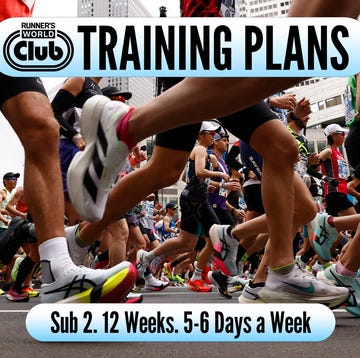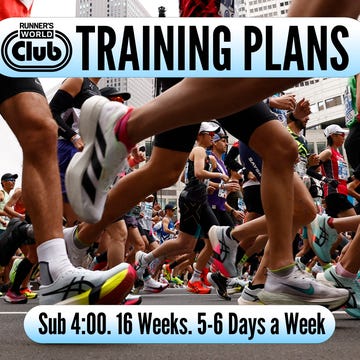If you want to become a fitter and faster runner, especially if you have a target race in mind, the best thing that you can do is select and follow a structured training plan that aligns with your goals and ability.
But there’s a catch: what is this mysterious ‘interval training’ that keeps appearing on your plan? What does it actually mean and entail? If you’re still new to running, interval training may seem like an alien concept – so here’s exactly what you need to know about interval training and how to build it sensibly into your training to attain the greatest benefits.
What is interval training?
Essentially, interval training is a form of speedwork, which involves running faster for relatively short periods to improve your speed overall. It can do wonders for your fitness and elevate your running performance.
What everyone's reading
If you’re new to running, you’ve probably completed several interval sessions without even realising it. Beginner training plans, such as run/walk plans or Couch to 5K plans, include various interval-like sessions, where bursts of running are followed by walking recoveries. Interval training follows an almost identical pattern to this – you run faster for a short period, rest (either by jogging, walking or, if you fancy, staying put), then repeat this sequence for a set number of times. It is as simple as that: run, rest, repeat.
What are the benefits of interval training?
When you first start running, the aim is to increase the length of time that you can run for continuously – and slotting in an extra easy run each week or slightly extending your running distances does help you to become that bit fitter. However, if you’ve been running consistently for some time, you might feel like your progress has stalled. This could be the perfect moment to start incorporating some interval training into your routine.
This plateau is only natural – it’s a result of your body adapting to the new stresses and strains that you’re placing upon it when you run. Although that’s great news for your general fitness, it means that you won’t see those big leaps in fitness, strength and speed that you did initially – until you mix things up again. So, incorporating an interval training session into your weekly schedule could be the big the thing that makes a difference.
When you push your body and raise your heart rate that bit higher, you train a different ‘system’ to the one that you work when you run slow and steady. Easy paced, conversational runs are great for building aerobic fitness, but if you want to train your body to reach a higher level of anaerobic fitness, you need to run harder, for short periods.
Regular weekly interval sessions could not only help you to get faster, but also bring about various other benefits...
It boosts your heart health
According to science, high-intensity interval training (HIIT) seems to be a good thing to do if you want to keep your ticker in good working order. A systematic review, published in Frontiers in Cardiovascular Medicine in 2022, found that HIIT is more effective than medium-intensity training at improving cardiorespiratory fitness.
It burns more calories
If weight loss is your goal, slow and steady runs are all well and good. However, if you push yourself during an interval session, your body will need to work harder to recover afterward, which burns more calories – even after you’ve finished exercising.
It leaves you with more free time
Interval training is a great way of fitting in a quality session in a short amount of time – this is particularly helpful if you need to frame your running around other commitments.
It gives you a runner’s high
Pushing yourself to run faster for short bursts can see those endorphins – the feel-good hormone – surge, leaving you feeling happy and energised.
Can beginner runners do interval training?
Definitely! But bear in mind that ‘harder’ and ‘faster’ are relative terms – there is no required pace for an interval session. Simply do your intervals at what is faster and harder for you.
As we said earlier, the run/walk sessions that you probably did when you first started running were themselves a form of interval training – so, in reality, you’re actually already familiar with the format. Now, it’s simply about pushing yourself to run that bit faster, while remembering that those recovery intervals can still be brisk walks if you need them to be. It’s all about taking it at your own pace.
How often should you do interval training?
Interval workouts can significantly improve your race times, but don’t forget that they are demanding sessions. Your bones, tendons and muscles need time to adjust to the strain of interval training.
When you begin to introduce these sessions into your routine, you want to make sure that you don’t overload your muscles and tendons and cause an injury – and to get the best out of your sessions, you need to be properly rested. Doing one interval session a week is plenty when you’re starting out. Then, when your body becomes used to interval training, you can add more to your training schedule – but never run two hard sessions on back-to-back days.
‘Be sure to give yourself at least one easy day between your harder sessions and bear in mind that most runners will respond better to two or even three easy days between such sessions,’ says running coach and RW columnist Tom Craggs.
Even elite athletes don’t do more than three interval sessions in a week and at least one of those will probably be at slightly lower intensity. So, make sure that you allow enough time for adequate rest and recovery.
How fast should you run each interval?
Before every run, you should always do a warm-up – and warming up well is particularly important ahead of an interval session, where you’re moving at a faster pace and pushing your body harder than normal.
For the interval workout itself, you’ll run at a high-intensity for a set distance or length of time, then jogging or walking briskly for a set amount of recovery time. You’ll repeat this sequence until you’ve finished the session, then do a gentle cooldown of jogging or walking.
For the high-intensity intervals, remember that no single pace fits all. Your pace depends upon your current fitness level, the type of workout that you’re doing and what you are training for. Shorter intervals often call for more speed and intensity, while longer ones, although slower, may be more useful if you’re training for a longer race like a marathon.
One of the easiest ways to gauge your pace is by using the rate of perceived exertion (RPE) scale, where one or two equals very light intensity and nine or 10 equals maximum intensity.
When you’re first starting out, for short intervals of 30 seconds to one minute, aim for a RPE of eight or nine. (Your recovery intervals, by contrast, should be at a light intensity of around two or three). For longer intervals of around two minutes, aim for an RPE of six or seven.
But what does this feel like? If you’re struggling to gauge whether you’re pushing hard enough (or too hard), do the talk test. If you can only say a word or two, that will be your eight to nine intensity pace. If you can say three to four words, that’s your six to seven intensity pace.
In the perfect interval session, you will run your final interval at the same pace as the first, staying consistent throughout. That is much better training than going all out in the first interval, then tailing off dramatically and slowing down with each one that follows. Achieving this consistency takes practice and even seasoned runners get it wrong. The important thing to remember is that finishing strong boosts your confidence and your fitness. Many top coaches would say that they’d prefer their athletes to finish a session feeling as though they could run one more interval than absolutely spent.
How to vary your interval sessions
Three key variables are at play when it comes to interval sessions: the number of intervals that you do, the length of the intervals that you do and the duration of your recoveries. This means that there’s an almost infinite number of variations you can do and that you can modify interval sessions easily.
The interval sessions that you choose can also depend upon your fitness level and/or goal race distance. Take time to learn what works for you – at first, it’s better to build up gradually and do just four to six shorter intervals, perhaps, with longer recoveries. As you progress, your pace will improve, your recoveries will become more effective and you’ll be able to run faster for longer.
4 interval sessions for beginners
One-minute intervals
If you’re new to interval training, the following session is a simple and effective way to get you into the swing of things:
- Five-minute warm-up of gentle jogging
- Run a fast interval for one minute (at 8-9 RPE)
- Recover with a two-minute jog or brisk walk (at 3-4 RPE)
- Repeat four to six times
- Five-minute cooldown of gentle jogging
Parkrun session
If you’re hoping to improve your 5K or parkrun time, try longer intervals at a lower intensity:
- Warm up with a brisk jog
- Run half a mile at your goal parkrun pace
- Recover with a 90-second jog or brisk walk
- Repeat six times
- Five-minute cooldown of gentle jogging
Pyramid session
If you prefer running based on time rather than distance, you could have a go at a pyramid session.
Between every interval, your recovery should last for one or two minutes and involve a very gentle jog or brisk walk. Tailor the session to your own goals – you can leave out the ‘top’ of the pyramid and peak at three minutes, or even add more minutes as you progress.
- Warm up with a brisk jog
- One-minute fast interval (at 8-9 RPE)
- Two-minute fast interval (at 7-8 RPE)
- Three-minute fast interval (at 7-8 RPE)
- Four-minute fast interval (at 6-7 RPE)
- Three-minute fast interval (at 7-8 RPE)
- Two-minute fast interval (at 7-8 RPE)
- One-minute fast interval (at 8-9 RPE)
- Five-minute cooldown of gentle jogging
Fartlek run
Fartlek sessions are a more fun and unstructured type of interval training – fartlek is Swedish for ‘speed play’, after all.
Pick a route over mixed terrain and include anything from 10 to 25 harder efforts lasting between 15 seconds and four minutes, or use lampposts, hills or landmarks as targets. Run easy or steady during the recoveries. You can find more fartlek workouts here.













